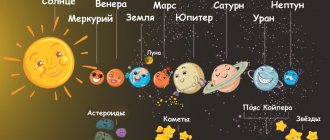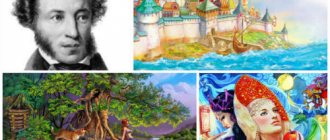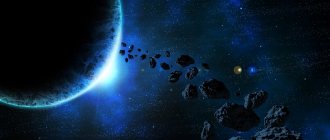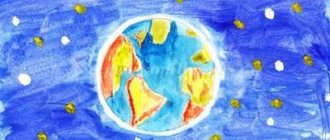1 . Today we will introduce the child to the planets of the solar system. To do this, you will need multi-colored balls of yarn, plastic balls or cards with planets (you can print them from us, see below). On a large sheet of paper, draw the sun in the middle and 8 orbits around it (more recently, Pluto is not the 9th planet of the solar system, so we draw 8 orbits). Explain to your child that the Sun is a very bright and hot star. It attracts 8 planets, which are each located in their own orbit and therefore do not collide. Then put all the “planets” into a bag, box or “magic hat”.
The process of the game is as follows: the child draws the first “ planet ” he comes across, you describe it and give the task to come up with and draw an inhabitant of this planet . Then you need to place the planet with its inhabitants in its orbit.
The description is given in order of distance of the planets from the sun:
• Mercury is the smallest planet and is closest to the sun. Loves to play hide and seek (hides behind the sun's rays, it is very difficult to see). If you stand
and Mercury and look into the sky, the sun will seem huge and it will move in strange zigzags. You can celebrate a birthday there every 88 days. Who lives on Mercury?
• Venus – the entire planet and even the clouds on it are orange. There are always thunderstorms here. There are so many clouds in the sky that you can never see the stars. This planet is very hot, the temperature is 3 times higher than that of boiling oil. Who can settle on this planet? What will they wear, what will they eat, and what kind of housing will they live in? Etc.
• Earth – the child must tell about this planet himself.
• Mars is a red planet. There are very high mountains here, 3 times higher than the highest mountain on Earth. There is no liquid water, only ice.
• Jupiter and Saturn – these planets do not have a solid surface. There is jelly inside the planet (closer to the center of the planet the gas becomes denser and turns into jelly), and outside there are multi-colored clouds. Saturn is 100 times heavier than Earth and really wants to lose weight. To do this, he spins a stone hoop around himself (the rings of Saturn). Oddly enough, Saturn's density is very low and it could easily float on water.
• Uranus is a “lounger” planet. She lies on her side all the time. It also has jelly inside, only the clouds outside are blue, because it is very cold on Uranus. The temperature there is 4 times lower than at the North Pole.
• Neptune is a water planet and has no land. There are storms here all the time.
2 . The Moon is a satellite of the Earth. Why the moon different? To explain this to your baby in a playful way, you will need a table lamp and a couple of balls. Our lamp will be the sun, and the balls will be the moon. By changing the position of the ball in relation to the lamp, you can see how the Moon (light and shadow) changes its appearance.
In Grandfather's right hand is the Young Moon,
on the left is the Full Moon.
The child has the Old Moon in his hand.
We sincerely hope that the educational games on our website will bring a lot of benefits to your child.
WHAT SHOULD I PRESS HERE?
How to easily remember the order of planets in the sky
In order, all the planets can be named by any of us: One - Mercury, Two - Venus, Three - Earth, Four - Mars. Five is Jupiter, Six is Saturn, Seven is Uranus, followed by Neptune.
Think back to how you memorized the colors of the rainbow as a child. The same principle can be applied to the names of the planets. Construct a phrase in which each word begins with the same letter as a planet in the solar system in the order of its location from the Sun. For example:
We are Mercury We will meet Venus Tomorrow My Earth Mars Young Jupiter Satellite Saturn Flying away Uranus Not for long Pluto
This is just an example, in fact, you can come up with anything, as long as it is close to your child’s spirit and he easily remembers the entire sentence. Now that we have figured out exactly how to present any information to children, we can move on to the direct knowledge that you will teach your young astronomers.
Finally, an interesting and simple story for children about what the solar system is. The solar system is all the cosmic bodies that revolve around the Sun according to their clearly defined trajectories. These include 8 planets and their satellites (their composition is constantly changing, as some objects are discovered, others lose their status), many comets, asteroids and meteorites. History of the emergence of planets There is no definite opinion on this matter, there are only theories and guesses. According to the most common opinion, about 5 billion years ago, one of the clouds of the Galaxy began to shrink towards the center and formed our Sun. The formed body had a tremendous gravitational force, and all the particles of gas and dust around began to connect and stick together into balls (these are the current planets). The Sun as a star and the center of the Solar System The planets in their orbits revolve around a huge star called the Sun. The planets themselves do not emit any heat, and if it were not for the light of the Sun that they reflect, then life on Earth would never have arisen. There is a certain classification of stars, according to which the Sun is a yellow dwarf, approximately 5 billion years old. Satellites of planets The solar system does not consist only of planets; it also includes natural satellites, including the well-known Moon. In addition to Venus and Mercury, each planet has a certain number of satellites, today there are more than 63. New celestial bodies are constantly being discovered thanks to photographs taken by automatic spacecraft. They are capable of detecting even the smallest satellite with a diameter of only 10 km (Leda, Jupiter). Characteristics of each planet of the solar system 1. Mercury. This planet is closest to the Sun; in the entire system it is considered the smallest. Mercury has a hard surface, like all four inner planets (those closest to the center). It has the highest rotation speed. During the day, the planet practically burns under the sun's rays (+350˚), and freezes at night (-170˚). 2. Venus. This planet is more similar to Earth than others in its size and brightness. There are always a lot of clouds around it, which makes observation difficult. The entire surface of Venus is a hot rocky desert. 3. Earth is the only planet on which there is water, and therefore life. It has an ideal location in relation to the Sun: close enough to receive light and heat in the right quantities, and far enough not to get burned by the rays. The Earth has one satellite - the Moon. 4. Mars. Some scientists have suggested that life also exists on this planet because it has a number of similarities with Earth. But numerous studies have found no signs of life there. At the moment, two natural satellites of Mars are known: Phobos and Deimos. 5. Jupiter is the largest planet in the solar system, 10 times larger than Earth in diameter and 300 times larger in mass. Jupiter consists of hydrogen, helium and other gases and has 16 satellites. 6. Saturn is the most interesting planet for children, as it has rings that are formed from dust, stones and ice. There are three main rings around Saturn, each about 30 meters thick. 7. Uranium. This planet also has rings, but they are much more difficult to see and only appear at certain times. The main feature of Uranus is its manner of rotation, performed in the “lying on its side” mode. 8. Neptune. Astronomy today calls this planet the last in the solar system. Neptune was discovered only in 1989, since it is located very far from the Sun. Its surface looks blue from space, which cannot but amaze us. Until 2006, there were 9 planets, including Pluto. But according to the latest scientific data, this space object is no longer called a planet. It’s a pity... Although, it has become easier for children to remember.
Didactic game “Arrange the planets correctly”
Topic: “Arrange the planets correctly”
Goal: To consolidate knowledge about the main planets.
Didactic material: Belt with sewn rays - ribbons of different lengths (9 pieces). Caps with images of planets.
It's so hot on this planet
That it’s dangerous to be there, friends.
-What is our hottest planet, where is it located? (Mercury because it is closest to the sun).
And this planet was shackled by a terrible cold,
The sun's rays did not reach her with warmth.
-What kind of planet is this? (Pluto because it is farthest from the sun and the smallest of all the planets).
A child in a Pluto cap takes hold of the longest ribbon No. 9.
And this planet is dear to us all.
The planet gave us life... (all: Earth)
-In what orbit does planet Earth rotate? Where is our planet from the sun? (On the 3rd).
A child in an “Earth” cap takes hold of ribbon No. 3.
Two planets are close to planet Earth.
My friend, name them quickly. (Venus and Mars).
Children wearing “Venus” and “Mars” hats occupy the 2nd and 4th orbits, respectively.
And this planet is proud of itself because it is considered the largest.
-What kind of planet is this? What orbit is it in? (Jupiter, orbit No. 5).
The child in the Jupiter cap takes place No. 5.
The planet is surrounded by rings
And this made her different from everyone else. (Saturn)
Child - Saturn occupies orbit No. 6.
What kind of green planets are they? (Uranus)
A child wearing a matching Neptune cap occupies orbit #8.
All the children took their places and began to revolve around the “Sun”.
The round dance of the planets is spinning.
Each has its own size and color.
For each the path is determined,
But only on Earth is the world inhabited by life.
To reinforce the material, you can make riddles about the planets.
A yellow circle is visible in the sky
And the rays are like threads. The Earth spins around, As if on a magnet. Although I am not old yet, But I am already a scientist - I know that it is not a circle, but a ball, Very hot... (Sun)
Six sons and two daughters are running around the light, Years and days will flash by, But they will not meet... (Planets)
Here is the planets little brother,
The size is too small. He is closest to the sun, that’s why he’s hot... (Mercury)
The tiny planet is first warmed by the Sun, And agile - the year on it is Eighty-eight days... (Mercury)
I often glow in the sky,
Your next door neighbor. I am Mercury’s sister, And I’m always hot... (Venus)
Only the Sun and Moon in the sky are brighter than her. And there is no hot planet in the solar system... (Venus)
Planet blue,
Beloved, dear, She is yours, she is mine, And it’s called... (Earth)
There are miracles on the planet: Oceans and forests, Oxygen is in the atmosphere, People and animals breathe it... (Earth)
Kamenyuki Fear and Horror are circling over the red planet. There is no mountain anywhere in the world Higher than on that planet... (Mars)
A heavyweight giant Throws lightning from the sky, He is striped like a cat, It’s a pity he’s losing weight little by little... (Jupiter)
This is the red planet
Next door to us. And in winter and even in summer it freezes with ice. It’s strange, no matter what you say, - Ice is not on top, but inside... (Mars)
Take a quick look through the telescope
He walks in orbit. There he is the boss over everyone, More than all other planets. There is no one larger in our solar system... (Jupiter)
All planets with poles,
Everyone has an equator. But you won’t find another planet with belts. In these rings he is alone, a very important gentleman... (Saturn).
Lush gas giant Brother of Jupiter and dandy He loves to have Rings of ice and dust nearby... (Saturn)
Lush gas giant
Brother of Jupiter and dandy He loves to have Rings of ice and dust nearby... (Uranus)
On the planet blue-blue
The wind is blowing very strong. It’s very cold on it - It consists of water, gas and ice... (Neptune)
He has been a Greek among his Roman brothers for many centuries, And rushes through the melancholy of space, lying on his side... (Uranus)
It takes five hours for the light to reach that planet, and therefore it is not visible in telescopes... (Pluto)
On a distant tiny planet,
There is no status of a “Big” planet. And offended, she is not visible through telescopes... (Pluto)
This yellow star
Always warms us, illuminates all planets, protects us from other stars... (Sun)
Sometimes he loses weight, sometimes he gets fatter,
It shines from the sky, but does not warm, And always looks at the Earth with only one side... (Moon)
Between Jupiter and Mars
It wouldn’t hurt to clean up - There are fragments from the planet, But there’s no broom... (Asteroid belt)
In space through the thickness of years
An icy flying object. Its tail is a strip of light, And the name of the object is... (Comet)
All the zodiac signs are there—
Aquarius, Virgo, Cancer. They glow both night and day, The astronomer looks there... (Space)
Lesson summary - travel in kindergarten in the senior group on the topic: Planets of the solar system
Lesson summary for the senior group of the preschool educational institution “Space Travel”
Program content: Introduce children to the names of the planets: Earth, Mercury, Mars, Venus, Jupiter, Uranus, Neptune, Pluto; Systematize children's ideas about the Universe, the Solar system and its planets; Enrich and expand children's ideas and knowledge about space. To develop children’s cognitive and intellectual abilities, creativity and the formation of a subjective-evaluative attitude towards the surrounding reality on this topic; Learn to be attentive and inquisitive. Continue to instill in children love for the Motherland; Foster a sense of pride in one’s native country, which participated in space exploration; To cultivate a caring attitude towards what is on our planet. Materials: images of planets, a “Solar System” poster, a hoop with ribbons and numbers from 1 to 9, an Astronomer’s costume, educational games (a diagram of a rocket, parts of a spacesuit design, musical accompaniment). Preliminary work: reading educational stories from the children's encyclopedia "Cosmos", a series of conversations on the topic "The Earth is the planet on which we live", observing the sky in the evening and morning, reading fiction and documentary literature about space;
drawing, appliqué, memorizing poetry. Progress of the lesson
Children sit on chairs that stand in a semicircle in front of the “solar system” illustration. Educator: children, if you look at your feet on the street, what will we see? Children: We will see earth, asphalt, grass. Educator: And if you look up, what do you see? Children: We will see the sky, clouds, the sun, and at night the stars, the month. Educator: What is the name of the planet on which we live? Children: The planet we live on is called Earth. Educator: What is the Earth like? Children: The earth is like a ball Educator: Correct. Earth and sky are our planet with seas and oceans, rivers, lakes and land. Beyond it is space. Reading a poem.
A pilot in a space rocket looked at the sky from above, No one, no one in the world has ever seen such beauty!
Oh, what beauty it is all around! We are not afraid of heights! And we, friends, inform you that there is no more beautiful earth. Educator: Since ancient times, the mysterious world of planets and stars has attracted the attention of people, beckoning them with its mystery and beauty. In the distant past, when people first began to explore the Earth, they imagined it as an inverted bowl resting on three giant elephants standing on the shell of a huge turtle. Several thousand years have passed since then. During this time, many generations of kind and intelligent people have changed on our planet. They built ships and, traveling around the world, confirmed the knowledge that our planet Earth moves at enormous speed in outer space, making one revolution around the Sun per year. Blue ball covered with white clouds. (Show illustration). This is what the Earth looks like from space. Astronauts who have seen our planet from the outside say that it is amazingly beautiful. Educator: Do you dream of going to space? Children's answers. Educator: If you really want to go into space, you can fly away. The bravest will be our cheerful, friendly crew. (There is a knock on the door. The Astronomer comes in to the music, holding an envelope with assignments in his hands.) Astronomer: Good afternoon, children! I am an Astronomer. One day, flying over a kindergarten, I saw a group of children watching the sun, then I noticed how in the evening and morning hours you watched the stars and the moon. You are so inquisitive, and I really love smart and inquisitive children. Tell me, kids, would you like to travel around my space kingdom? Therefore, I want to invite you on an unusual space journey. Interesting adventures and various challenges await you. Do you agree? Aren't you afraid of difficulties? Distant stars are shining in the sky, They are calling smart guys to visit. It doesn't take long for us to get ready for the trip - and now we are just ready for the flight. Let's play. First, let's remember what needs to be prepared for a flight into space. Children: Since we are going to fly, we need to build. (Starship.) Educator: Correct. And we will build according to the project that our friend kindly provided us with. The astronomer offers an envelope with the first task. Children build a starship from geometric shapes. Physical education lesson In order to control a rocket, you need to become strong and dexterous. They don’t take the weak into space, because flying is not easy work! We will train, we will gain strength. Left, right, turn around, turn around yourself. (3-4 rubles) Squat, (4-5 rubles) Jump (7-8 rubles) And sit down in your seats Didactic game “Cut-out pictures” Astronomer: To fly into space you need special suits - spacesuits. I suggest you collect them. Children assemble spacesuits from pieces. Educator: And now the children are with you, we are flying away on a starship. Put on imaginary spacesuits. (Children tap their fingers on the head, shoulders, arms, torso, legs.) Go to the ship’s interior, select a space chair. It is necessary to put on the straps and fasten the seat belts. Starship, starship takes flight. Five, four, three, two one (the sound of a rocket taking off) During the launch, we will shake a little until we pass through the dense layers of the atmosphere. (Children imitate shaking) It won’t take long, soon our ship will enter a calm flight mode (the shaking stops, the song “Earth in the Porthole” sounds). Children, we have entered a calm mode.
During the flight you can move around our ship. Listen to the command “Unbuckle your seat belts.”
Look, what do you see in the porthole? Children: We see the Sun, planets, stars, comets. Educator: We live in the solar system, in a large “family” of planets. They are all different in size, natural conditions, and structure. They fly around the Sun in different ways. Some are closer to him, others are further away. Planets can be seen in the sky because they are illuminated by the Sun. Sunlight reflects off the planets, which is why the planets can be seen from Earth. They are especially visible at night, when they glow like bright stars. Earth is the third planet from the Sun. (Then children get acquainted with the names of other planets: Mercury, Mars, Venus, Jupiter, Saturn. Show illustrations). Didactic game “Arrange the planets correctly.” Each planet has its own path. Believe me, it cannot be pulled out of orbit. Our planets revolve around the Sun. They are all warmed by the Sun in different ways. The child “Sun” is selected, and a belt with sewn rays-ribbons of different lengths is put on him. There are nine of them. Nine children have hats with images of planets on their heads; they differ in size and color. There are rings on Saturn's cap. At the end of each ribbon there are numbers from 1 to 8. Mercury-child: The very tiny planet First is warmed by the Sun, And the year on it is Eighty-eight days. -What is our hottest planet? Where is it located? (Mercury, because it is closest to the sun.) The Mercury child takes up ribbon No. 1. The Earth is a child: There is beauty on the planet: Oceans and forests, Oxygen is in the atmosphere, People and animals breathe it. — In what orbit does our planet Earth rotate? Where is our planet from the sun? (In 3rd place) Child-Earth takes up ribbon No. 3. Venus - child: Only the Sun and Moon are brighter in the sky than she is. And there is no hotter planet in the solar system. — Venus, kids, was once called “sister of the Earth.” On the surface of Venus the temperature is about five hundred degrees. Child-Venus takes up tape No. 2. Mars - child: Kamenyuki Fear and Horror are circling over the red planet. There are no mountains in the world Higher than on this planet. — What place will Mars take? Child Mars takes up tape No. 4. Jupiter is a child: A heavyweight giant Throws lightning from the sky, He is striped, like a cat, It’s a pity that he is losing weight little by little The largest planet, what is it called? What orbit is it in? (Jupiter, orbit No. 5) Child-Jupiter takes up ribbon No. 5 Saturn - child: Curvy gas giant Brother of Jupiter and dandy Loves rings of ice and dust flying around. Child-Saturn occupies orbit No. 6. Uranus - child: What is the Green planet? Child-Uranus occupies orbit No. 7. Neptune - child: On the planet blue-blue The wind is blowing very strong. There is no summer there at all - Winter is very long here. Child Neptune occupies orbit No. 8. All children have taken their places and begin to revolve around the “Sun”. The round dance of the planets is spinning. Each has its own size and color. For each, the path is determined, But only on Earth is the world populated with life. It's time for the astronauts to return to Earth. Stand in a circle, hold hands. Close your eyes, turn on the energy of love for your native Earth and pass this energy on to your friends. Observe what happens inside you. (space music sounds)
Let's fly home!
Open your eyes. Here we are at home. Let's take off the spacesuit. (Children clap their hands around their bodies: left, above, right, below.) Good! Summary of the lesson. And at the end of our space lesson, let's thank our Astronomer and wish him successful flights into space and new space discoveries! (Children say goodbye to the Astronomer)
We recommend watching:
DIY board game for kindergarten on the theme: Space A project on the theme “Space” in the middle group of the kindergarten. Video presentation Summary of GCD (application) in the middle group of kindergarten on the topic: Space Entertainment for children of the preparatory group in kindergarten on the topic: Space
Similar articles:
Conversation in the preparatory group “The sun is the source of life on earth”
Conversation in the preparatory group. The Moon is the Earth's satellite
Conversation for children of the senior group “Planets of the solar system”
Stories about Gagarin for children
Summary of the lesson “Starry Sky” in the middle group






